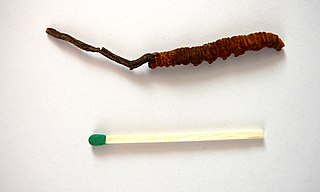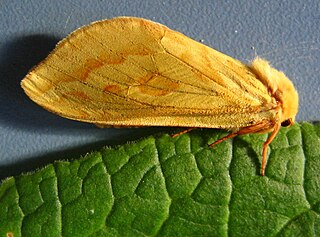
Ophiocordyceps sinensis is known in English colloquially as caterpillar fungus, or by its more prominent names yartsa gunbu, or dōng chóng xià cǎo or Yarsha-gumba or Yarcha-gumba, यार्सागुम्बा or Keeda Jadi, or ရှီးပတီး. It is an entomopathogenic fungus in the family Ophiocordycipitaceae. It is mainly found in the meadows above 3,500 meters on Tibetan Plateau in Southwest China and Himalayan regions of Bhutan and Nepal. It parasitizes larvae of ghost moths and produces a fruiting body which used to be valued as a herbal remedy and in traditional Chinese medicine. Caterpillar fungus contains the compound Cordycepin, an adenosine derivative. However, the fruiting bodies harvested in nature usually contain high amounts of arsenic and other heavy metals so they are potentially toxic and sales have been strictly regulated by the CFDA since 2016.

The Hepialidae are a family of insects in the lepidopteran order. Moths of this family are often referred to as swift moths or ghost moths.

The ghost moth or ghost swift is a moth of the family Hepialidae. It is common throughout Europe, except for in the far south-east.
The Hepialoidea are the superfamily of "ghost moths" and "swift moths".
Bipectilus is a genus of moths of the family Hepialidae. There are eight described species in the genus, distributed through China, Nepal and Vietnam.

Endoclita is a genus of moths of the family Hepialidae. There are 60 described species found in eastern and southeast Asia and the Indian subcontinent.
Thitarodes is a genus of moths of the family Hepialidae. In English Thitarodes is known as "ghost moth". They are found in eastern Asia. The majority are restricted to the Tibetan Plateau. Often in Chinese entomological nomenclature Thitarodes is still referred to as Hepialus, although the name was changed back in 1968. Furthermore, some authors use incorrectly the term "bat moth" which is a bad translation of the Chinese term for ghost moth.
Bipectilus gracilirami is a species of moth of the family Hepialidae. It is known from Nepal.
Bipectilus latirami is a species of moth of the family Hepialidae. It is known from Nepal.
Bipectilus omaiensis is a species of moth of the family Hepialidae. It is known from China (Szechuan).
Bipectilus paraunimacula is a species of moth of the family Hepialidae. It is known from China (Hunan).
Bipectilus tindalei is a species of moth in the family Hepialidae, known to inhabit Vietnam and Thailand.
Bipectilus unimacula is a species of moth of the family Hepialidae. It is known from China (Kiangsu).
Bipectilus yunnanensis is a species of moth of the family Hepialidae. It is known from China (Yunnan).

Sthenopis pretiosus, the gold-spotted ghost moth, is a species of moth of the family Hepialidae. It was first described by Gottlieb August Wilhelm Herrich-Schäffer in 1856. It can be found in found Brazil, Venezuela and in the north-eastern United States and south-eastern Canada.
Hepialus xiaojinensis is a species of moth of the family Hepialidae. It is found in Sichuan, China.
Thitarodes bibelteus is a species of moth of the family Hepialidae. It is found in Yunnan, China.
Thitarodes latitegumenus is a species of moth of the family Hepialidae. It is found in Yunnan, China.
Thitarodes deqinensis is a species of moth of the family Hepialidae. It is found in Yunnan, China.




